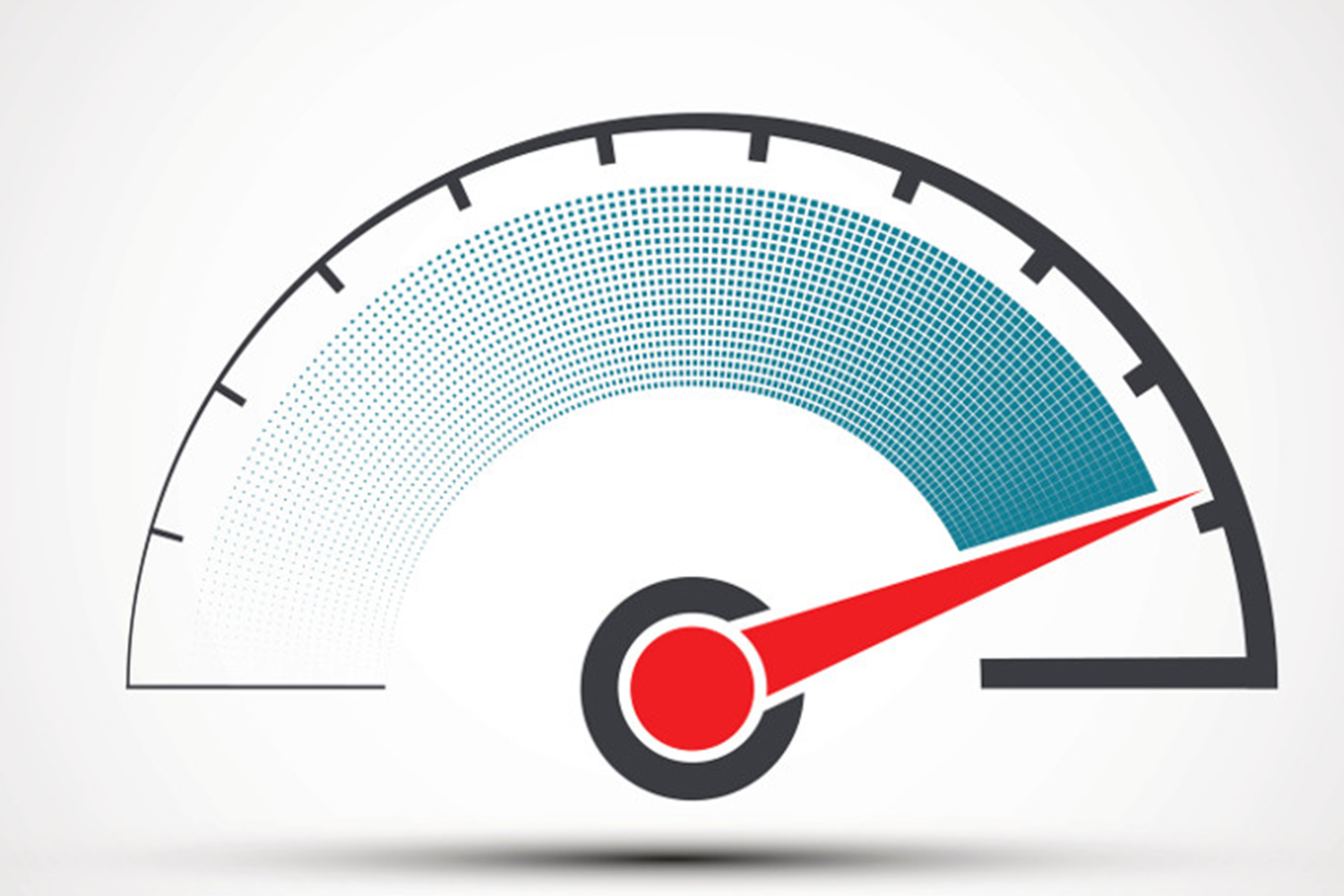4 Ways to Drastically Improve Customer Satisfaction

We all know customer service is important, but you may not realize it’s getting even more important today. A 2017 survey by Deloitte found that not only was customer experience the leading priority for customer-facing businesses (with 88% of respondents listing it the main priority), but that number was a 17% increase from 2015. In every category, customer experience and satisfaction grew in importance over the last several years.
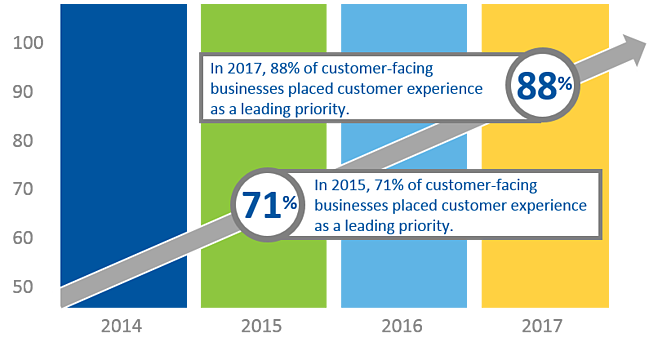
What are you doing to ensure your organization is keeping up? Do you have a strategy to enhance your customer experience? Vertical has some ideas that can be simple to implement with the right technology.
1 Text With Them
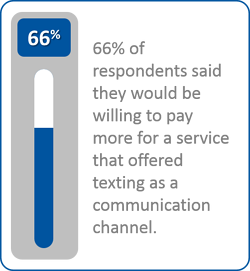
We live in a texting world. It’s the main form of communications for people under the age of 35 and the desire to text is invading the business world as well. A study by Market Strategies International showed that texting was the preferred method for contact with a company. 66% of respondents to the survey said they would be willing to pay more for a service that offered texting as a communication channel.
Obviously, there are great improvements in customer service here and, potentially, the opportunity to increase your margins. It’s very likely some of your sales team is already texting with customers, but they are using their personal cell phones. You don’t own that channel and there is no accountability.
The good news is that business communications systems now offer you the ability to offer and own text messaging as part of your phone solution. Cloud solutions like 8×8 give you the ability to upgrade your communications to include business text messaging. The best part is that this isn’t a major CAPEX investment. These cloud solutions allow you to buy in quickly and easily to the solution and start taking advantage of texting.
Your sales and service teams can begin using text messaging from your business phone numbers. You own the relationship and can also get the benefits. You will be meeting their customer service expectations and gaining a competitive advantage as well.
2 Don’t Make Them Wait In Line
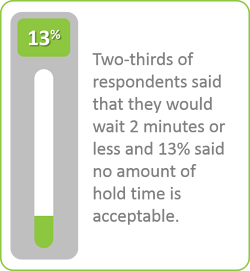
A 2019 Google Consumer Survey asked 1,500 consumers how long is acceptable to wait on hold? About 2/3 of respondents said that they would wait 2 minutes or less and 13% said no amount of hold time is acceptable. Given that research shows 1/3 of customers who hang up on your customer service never return, these are concerning numbers.
There are ways to address this. Offering other forms of communication will certainly help (see Tip 1). If you have a call center already handling calls, consider expanding to offer web chat, email, and social media as alternate ways to contact your team. These methods are increasingly popular and feel less stressful to your customers. They can multi-task while using them.
Another solution is to closely monitor hold times. Your communications solution ought to be able to offer a real-time view of hold times and let everyone see what’s happening. This lets you proactively throw resources at the problem by getting everyone on the phones during peak service times. Reporting can also tell you what those peak times are, so you can proactively plan for them.
The best option may be eliminating hold times all together. A great feature for improving customer satisfaction is called “Call-Back”. This features allows callers to enter their phone number and hang up. Now, just their phone number stays in queue. When they get to the top of the queue, the system calls them back and connects them automatically to an agent.
The power of call-back is dramatic. Customers who use it report that they don’t feel like they are waiting at all. They can do other things. This is a dramatic change in the customer experience.
3 Optimize Their Options
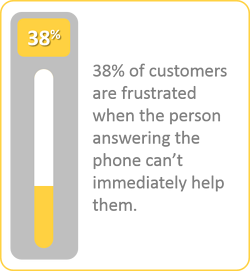
A key frustration for callers is inability to find the option they are looking for. Whether it’s hunting through the options on a menu, or talking to a live person who doesn’t have the answer, customers get frustrated when they can’t find a solution. While the solution of a live answer to all calls is often the answer for many smaller companies, 38% of customers are frustrated when the person answering the phone can’t immediately help them.
The ideal solution here is to get the customer to the solution they are looking for quickly. One of the best ways to do this is by using analytics to find out what most customers are looking for. The data is probably already in your phone system. The question is how easy it is for you to get it out. Below is an example of great visualizations showing what options on your menus are being chosen most often. Information like this allows you to optimize customer choices. If everyone is choosing option 4, make it option 1. If no one is choosing option 2, then eliminate it.

8×8 chart showing the most common paths of callers through your system.
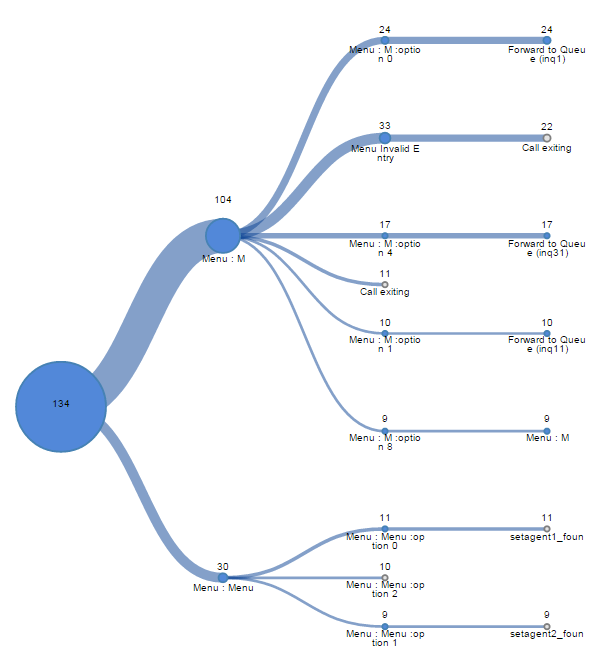
8×8 menu tree showing how many people chose each option.
Using this kind of data can drastically improve the customer experience and help your customers quickly find the information they are looking for when calling.
Another way to optimize the customer experience is a capability called “Last-Agent Routing.” Consider this scenario. A customer calls in and takes to one of your customer service reps. They have a positive experience and hang up the phone. The customer suddenly realizes they had one more question to ask. The normal experience would be to call back in, wait on hold, and then talk to a random member of your team who knows nothing about the previous experience. This is not a good customer experience. They will have to explain everything all over again.
What if the customer called back in and was immediately connected to the person they had just been talking to? Wouldn’t that experience almost seem magical? Last-Agent Routing can accomplish this by recognizing the customer’s caller ID and prioritizing them to talk the last person they talked to. The system can optimize the customer’s experience automatically. This will be a highly satisfied customer.
4 Empower Your New Hires
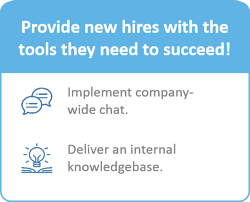
One of the critical holes in your organization occurs when you bring in new employees. They simply don’t have the years of experience the rest of your staff provides. They don’t know the answers to common questions, they don’t even know who to ask for those answers. They are the live answer person without the answers that we discussed in Tip #3. When the new hire puts a customer on hold to go find the answer, it makes the problem worse! The new hire may have great customer service skills, but they don’t have the information yet.
One way to help them is by using chat throughout your company. If your new hire can chat with more experienced team members then their ability to deliver good customer service increases exponentially. They don’t have to put the customer on hold. They have ready access to simple questions. They know what to do in response to unexpected queries. Chat becomes a way to instantly improve the new hire’s ability to take care of your customers.
Another great technique is to have an internal knowledgebase. This can have answers to common questions readily at hand for the new hire to reference. Now, they don’t even need to bother anyone else to have access to the knowledge. And by using a tool like this, the new hire is teaching themselves every time they answer the customer’s question. They are self-training. There are a number of tools out there on the market, but the ideal solution is to have it integrated directly into your communication system. If you have a dedicated team of call handlers (especially one that has regular employee turnover), then having an integrated knowledgebase can really accelerate your on-boarding and improve customer satisfaction all around.
Let Vertical Help
Drastically improving customer satisfaction is an achievable goal. If any of these tips sound helpful, contact Vertical Communications today to help you start implementing improvements and see your customer satisfaction sky-rocket!

